Smart2 30A Solar MPPT Battery Charger Controlle DC 12V/24V/48V
- Loading Port:
- China main port
- Payment Terms:
- TT OR LC
- Min Order Qty:
- 20 unit
- Supply Capability:
- 9999 unit/month
OKorder Service Pledge
OKorder Financial Service
You Might Also Like
Smart2 30A Solar MPPT Battery Charger Controller
More Pictures
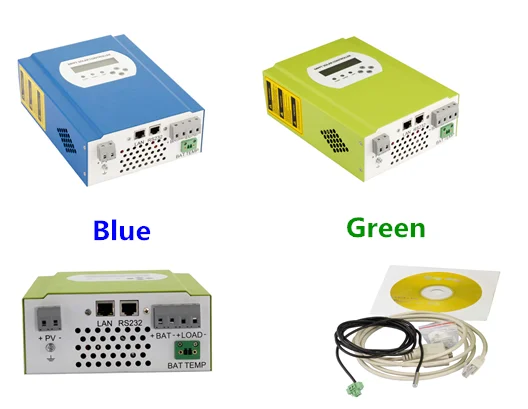
LAN/RS232 connecting
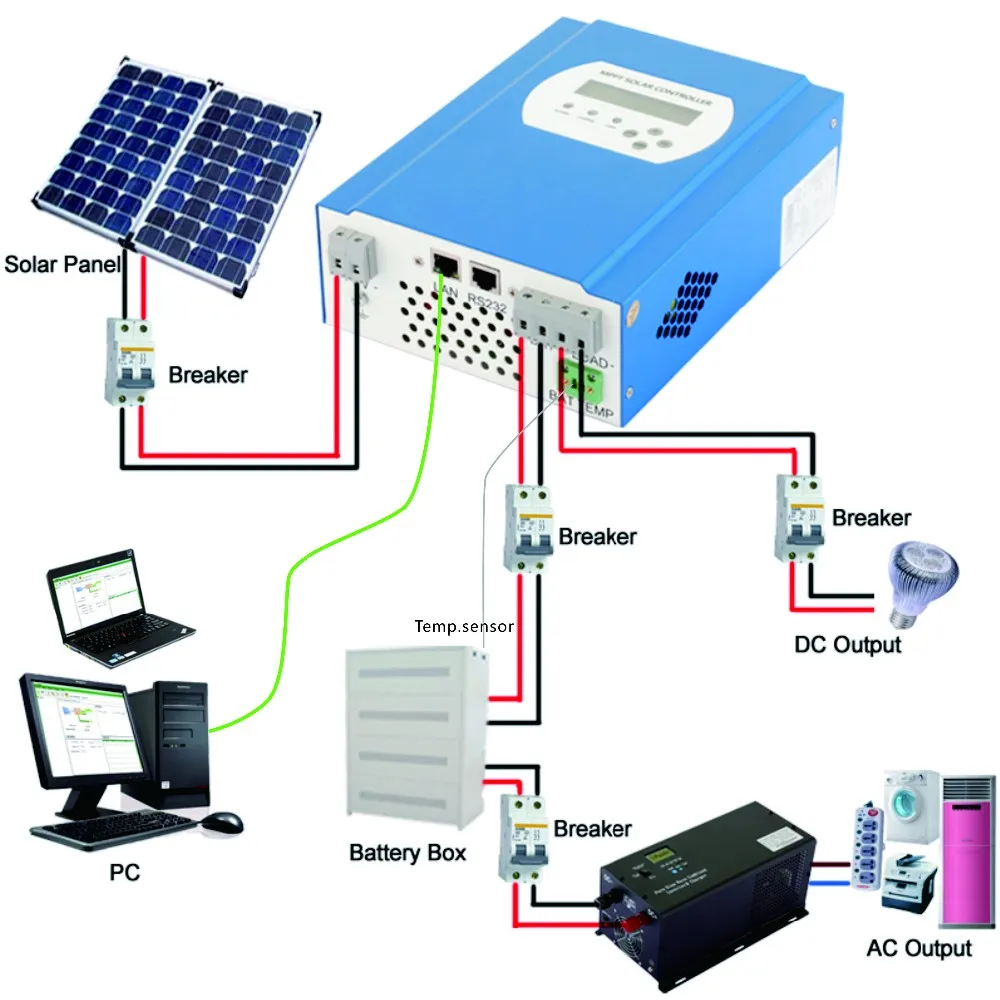
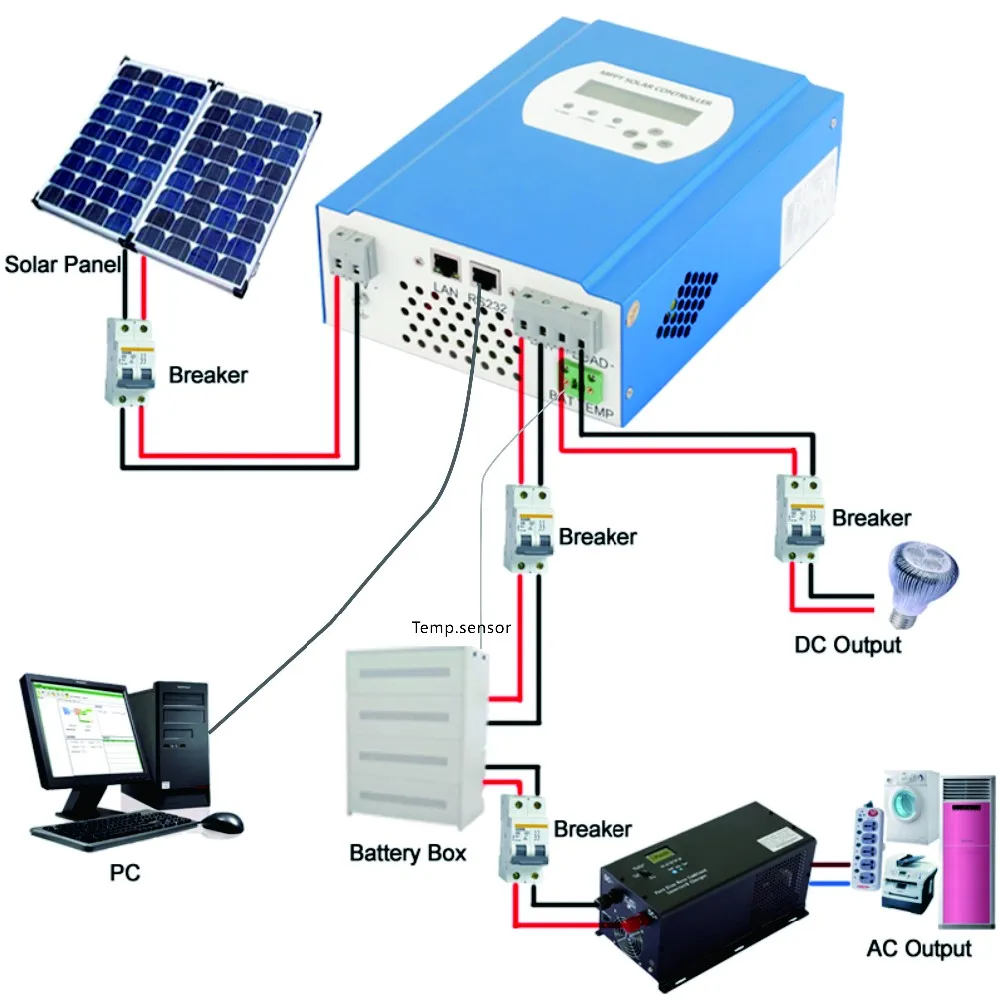
Upper PC software (real time monitor)
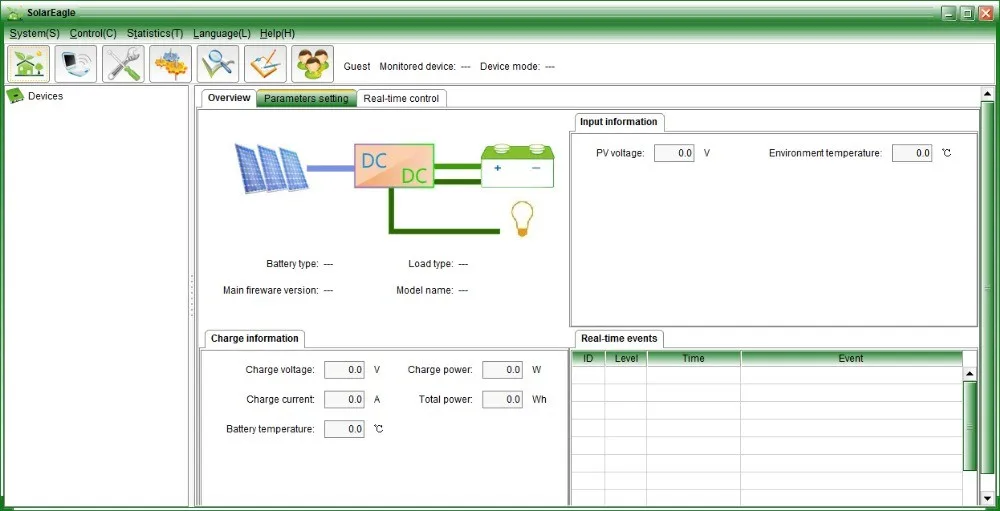
Application
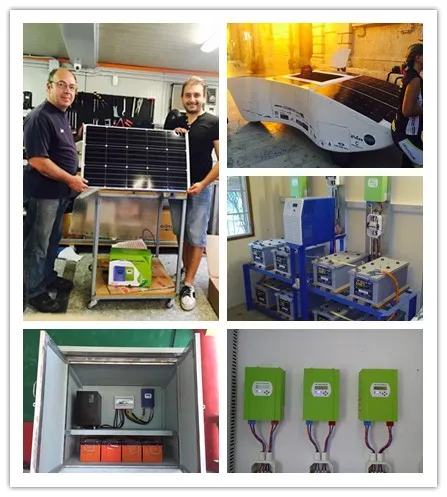
Feature
1. MPPT charging mode, conversion efficiency upto 99%
2. Maximum PV input voltage up to DC150V
3. RS232 and LAN communication port
4.Discharge mode: ON/OFF mode, double time control mode, PV voltage control mode, PV voltage+time delay mode.
5.LCD and LED show various parameters
6. Controllers can be connected in unlimited parallels
7. CE,RoHS, FCC certification approved
8. 2 years warranty, lifelong free technical service.
Parameter
| Model:I-P-SMART2-20A/25A/30A -series | 20A | 25A | 30A | ||
| Charge Mode | Maximum Power Point Tracking | ||||
| Method | 3 stages: fast charge(MPPT),constant voltage, floating charge | ||||
| System Type | DC12V/24V/48V | Automatic recognition | |||
| PV Modules Utilization Rate | 12V/24V/48Vsystem | ≥99% | |||
| Input Characteristics | |||||
| MPPT Working Voltage and Range | 12V system | DC18V~DC150V | |||
| 24V system | DC34~DC150V | ||||
| 48V system | DC65~DC150V | ||||
| Input Overvoltage Protection Point | 12V/24V/48V system | DC150V | |||
| Max. PV Power | 12V system | 286W | 357W | 429W | |
| 24V system | 572W | 715W | 858W | ||
| 48V system | 1144W | 1430W | 1716W | ||
| Output Characteristics | |||||
| Selectable Battery Types | 12V/24V/48Vsystem | Sealed lead acid, vented, Gel, NiCd battery | |||
| (Default type is GEL battery) | (Other types of the batteries also can be defined) | ||||
| Rated Output Current | 12V/24V/48V system | 20A | 25A | 30A | |
| Physical | |||||
| Pc (communication port) | RS232 or LAN | ||||
| Measurement D*W*H(mm) | 220*165*70mm | ||||
| N.G(kg) | 2kg | ||||
| Color | Blue/Green/OEM (optional) | ||||
| Safety | CE, RoHS,FCC | ||||
Certifications |
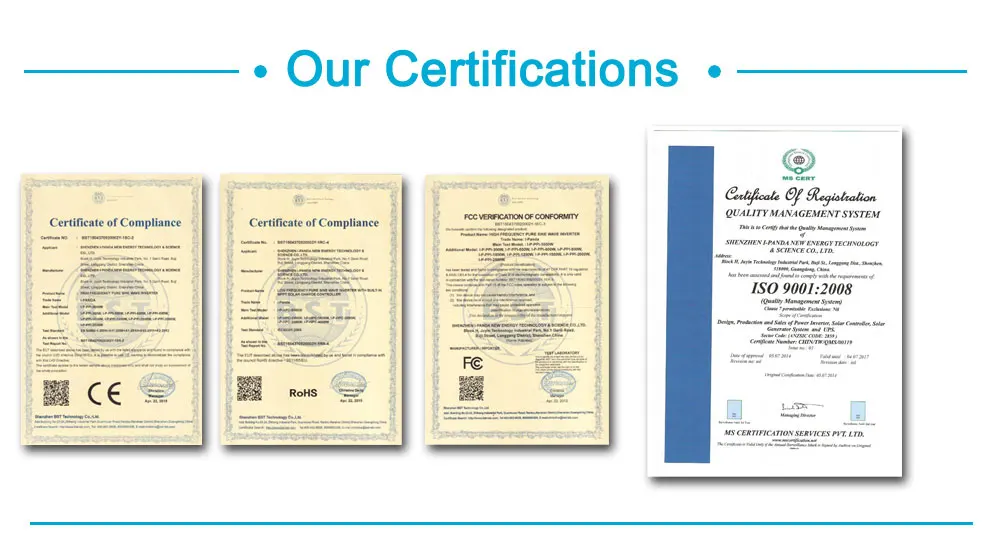
F&Q: |
Q1. How to ensure and monitor the products quality?
A1: We have established a perfect Quality Management System, In strict
accordance with ISO9001: 2008 quality system and ISO14001 environment system for quality assurance management;
Our ISO9001:2008 Quality System certificate encoding: CHIN/TW/QMS/00119;
Our ISO14001 Environment System certificate encoding: CHIN/TW/EMS/00028;
Q2. What is the warranty of products?
A2: The warranty period of different products are different; 5 years, 3 years, 2 years, 1 years; More details please refer to the product specification or manual; we will provide free life-long technical support ;
Q3. What is the difference between MPPT&PWM?
A3. MPPT charging mode, peak efficiency up to 99%, saving 30%~60% solar panel than traditional PWM controller.
- Q:How does a solar controller handle the display of system information?
- A solar controller handles the display of system information by collecting data from various sensors and components within the solar power system, such as the solar panels, battery, and load. It then processes and interprets this data to calculate and display important system information, such as the current battery voltage, charging status, load consumption, and other relevant parameters. This display can be in the form of an LCD screen or LED indicators, providing real-time information about the system's performance and enabling users to monitor and optimize their solar power system effectively.
- Q:Can a solar controller be used with a battery bank?
- Yes, a solar controller can be used with a battery bank. A solar controller regulates the flow of energy from solar panels to the battery bank, ensuring that the batteries are charged efficiently and preventing overcharging or damage to the batteries.
- Q:Can a solar controller be used with a solar-powered pool heater?
- Yes, a solar controller can be used with a solar-powered pool heater. A solar controller helps regulate and optimize the performance of solar panels, ensuring that the pool heater operates efficiently and effectively. It allows for better control of the solar heating system, monitoring temperature levels and adjusting the flow of solar energy to maintain desired pool water temperatures.
- Q:Can a solar controller be used with solar-powered ventilation systems?
- Yes, a solar controller can be used with solar-powered ventilation systems. The solar controller regulates the flow of power from the solar panels to the ventilation system, ensuring optimal performance and efficient utilization of solar energy. It helps control the voltage and current supplied to the ventilation system, preventing overcharging or undercharging of the batteries, and maximizing the system's overall effectiveness.
- Q:How do you protect a solar controller from lightning strikes?
- To protect a solar controller from lightning strikes, it is recommended to install surge protection devices (SPDs) on both the solar panel side and the controller side. These SPDs divert the excess voltage caused by lightning strikes, preventing it from damaging the controller. Additionally, grounding the system properly and using high-quality cables and connectors can also help in minimizing the risk of damage from lightning strikes.
- Q:Can a solar controller handle power surges from the inverter?
- Yes, a solar controller is designed to handle power surges from the inverter. It acts as a protective device that regulates and manages the flow of power between the solar panels, battery, and inverter, ensuring that power surges do not damage the system.
- Q:Are there any safety precautions to consider when installing a solar controller?
- When installing a solar controller, there are various safety precautions that should be taken into consideration. 1. Electrical Safety: Prior to installing or working on the solar controller, it is crucial to switch off power to the system. This will prevent electric shocks and other potential accidents. Additionally, it is important to use appropriate electrical insulation and protective gear while working with the controller. 2. Secure Mounting: It is necessary to securely mount the solar controller to a sturdy surface to avoid the risk of it falling or getting damaged. Furthermore, it should be positioned away from any flammable materials or sources of heat to minimize the possibility of fire. 3. Connectors and Wiring: The correct connectors and wiring must be used during the installation of the solar controller. This ensures proper grounding of the system and reduces the chance of short circuits or electrical malfunctions. It is also essential to carefully follow the manufacturer's instructions and guidelines for wiring and connecting the controller. 4. Overcurrent Protection: Incorporating overcurrent protection devices, such as fuses or circuit breakers, into the solar controller is necessary to prevent damage to both the controller and the rest of the system in the event of a power surge or overload. These protective devices should be appropriately sized and installed based on the system's requirements. 5. Adequate Ventilation: Since solar controllers generate heat during operation, it is important to ensure proper ventilation around the controller. This prevents overheating and potential damage to the controller and other components. It is recommended to install the controller in a well-ventilated area or utilize additional cooling measures if needed. 6. Regular Maintenance: Once the solar controller is installed, regular inspection and maintenance are crucial to ensure safe and efficient operation. This includes checking for any loose connections, cleaning the controller, and keeping it free from dust or debris. By adhering to these safety precautions, individuals can reduce the risk of accidents, electrical hazards, and equipment damage while installing and operating a solar controller.
- Q:What is the purpose of the battery over-discharge protection feature on a solar controller?
- The purpose of the battery over-discharge protection feature on a solar controller is to prevent damage to the battery by ensuring it does not get discharged below a certain voltage threshold. When a battery is over-discharged, it can lead to irreversible damage, reduced capacity, and shortened lifespan. Solar controllers continuously monitor the battery voltage and when it reaches a predetermined low voltage level, the over-discharge protection feature activates. This feature then cuts off the power supply from the solar panels to the battery, preventing further discharge. By doing so, it helps to safeguard the battery from being drained excessively, which could result in permanent damage. By implementing battery over-discharge protection, solar controllers help to extend the lifespan of the battery and ensure its optimal performance. It is particularly crucial in off-grid solar systems where batteries are the primary source of energy storage. Without this protection feature, the battery could be subjected to deep discharge cycles, leading to reduced efficiency and overall system performance. In summary, the purpose of the battery over-discharge protection feature on a solar controller is to prevent battery damage, increase its lifespan, and maintain the efficiency of the solar system.
- Q:How does a solar controller prevent thermal runaway in batteries?
- A solar controller prevents thermal runaway in batteries by monitoring and regulating the charging process. It ensures that the batteries are charged within their safe operating temperature range, preventing excessive heat buildup. Additionally, the controller may incorporate features like temperature sensors, voltage and current regulation, and overcharge protection to further safeguard against thermal runaway.
- Q:How do you determine the right size of solar controller for a system?
- When determining the appropriate size of a solar controller for a system, several important factors must be taken into account. First and foremost, it is necessary to compute the maximum current and voltage that will be produced by the solar panels. This can be achieved by multiplying the panels' maximum current rating by their maximum voltage output. Subsequently, it is essential to establish the maximum current and voltage capacity of the charge controller. This information is typically provided in the manufacturer's product specifications or datasheet. Ideally, the solar controller should have a current and voltage rating that exceeds the maximum values generated by the solar panels. This ensures that the controller can effectively manage and regulate the energy generated by the panels without becoming overwhelmed. Moreover, it is advisable to consider any future expansion plans for the system. If there are intentions to add more solar panels in the future, it is prudent to select a solar controller with a higher capacity than what the current system requires. It is important to highlight that the size of the solar controller should also be compatible with the other components of the system, such as the battery bank and inverter. Consequently, it is crucial to ensure that all components are appropriately matched and compatible with one another. To summarize, determining the appropriate size of a solar controller entails calculating the maximum current and voltage generated by the solar panels, comparing these values with the specifications of the controller, and taking into account any future expansion plans. Consulting a solar professional or referring to manufacturer guidelines is recommended to ensure accurate sizing for your specific system.
1. Manufacturer Overview |
|
|---|---|
| Location | |
| Year Established | |
| Annual Output Value | |
| Main Markets | |
| Company Certifications | |
2. Manufacturer Certificates |
|
|---|---|
| a) Certification Name | |
| Range | |
| Reference | |
| Validity Period | |
3. Manufacturer Capability |
|
|---|---|
| a)Trade Capacity | |
| Nearest Port | |
| Export Percentage | |
| No.of Employees in Trade Department | |
| Language Spoken: | |
| b)Factory Information | |
| Factory Size: | |
| No. of Production Lines | |
| Contract Manufacturing | |
| Product Price Range | |
Send your message to us
Smart2 30A Solar MPPT Battery Charger Controlle DC 12V/24V/48V
- Loading Port:
- China main port
- Payment Terms:
- TT OR LC
- Min Order Qty:
- 20 unit
- Supply Capability:
- 9999 unit/month
OKorder Service Pledge
OKorder Financial Service
Similar products
New products
Hot products
Related keywords





























